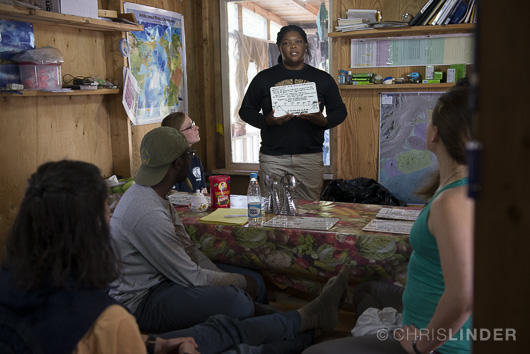Next on the agenda is the tundra. The anticipation has been building for the past seven or so days to go to this mysterious place. So far we have been in the boreal forests of Cherskiy, where permafrost and larch trees have been the most common topic of discussion. As someone who has never seen the boreal forest or the tundra before, the thought of what it will be like to live in the tundra for two and a half weeks is both exciting and mystical. I imagine a flat landscape with no trees, low shrubs, plenty of mosses, grasses and lichen, crystal clear lakes and streams as well as pockets of ponds and depressions with some reindeer sightings (hopefully).
For me, this journey of living on a barge in a Russian river in the middle of a boreal forest has been an adventure. Being from Massachusetts, I would have to drive at least an hour to get a big enough hill to hike. Having never camped outside of my back yard, there have been many challenges and surprises thus far. For instance, just hiking up from the barge to Orbita (the station in Cherskiy where we eat our meals) with all of my gear on tends to be a challenge. The awkwardness of my movements with clunky boots and layers of clothes have left me in a sweat on most days. The thick vegetation in the forests turns hiking into bushwhacking and leaves me struggling to walk and out of breath. On the good side, I am getting much better at it. It helps that this is one of the most beautiful places that I have ever seen. The pristine environment, almost untouched by human life and activity, is somewhat indescribable. The treeline and the mountains in the distance combined with the piney scent of the Labrador tea plants is irresistible. The only downside to all of this nature are the mosquitos… Only bug shirts and 100% Deet can keep them at bay, and even then they seem to creep into every aspect of daily life and activities.

Jess presents her research plan on the barge.
Scientifically, my horizons have expanded exponentially and continue to do so daily. I came here with the hopes of measuring methane (a potent greenhouse gas), but no idea how to accomplish it. Now, having had some experience helping others in the field with their studies and just listening and reading up on the area and what it has to offer, my thoughts are coming together. I now know that I am interested in studying the pockets of earth that have begun to sink inward due to the thawing of the permafrost (ice) beneath the earth, the water that pools in them and methane that these small thaw ponds or depressions may emit compared to the methane that the vegetation and the soil around these ponds emit. It took me a while to get to this point simply because for the past nine months, and throughout my four years in college, my focus has been on marine environments as well as the biology behind the processes that happen in the ocean and the creatures that live there. I have spent the past two summers focusing on marine ecological studies and global warming effects. Streams, ponds, and lakes have different processes that contribute to global warming. The great thing about the people in the Polaris Project, and our hosts at the Northeast Science Station, is their breadth of knowledge. It has been really awesome getting to know each person as well as learning science by asking them questions about my project and its aspects.
So far it has been an amazing journey! I cannot wait until we get to the tundra and turn this experience into a somewhat different direction—one filled with learning, friendship and good science! Until next time…



